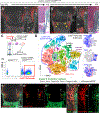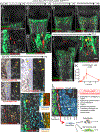Growth Plate Borderline Chondrocytes Behave as Transient Mesenchymal Precursor Cells
- PMID: 30888720
- PMCID: PMC6697228
- DOI: 10.1002/jbmr.3719
Growth Plate Borderline Chondrocytes Behave as Transient Mesenchymal Precursor Cells
Abstract
The growth plate provides a substantial source of mesenchymal cells in the endosteal marrow space during endochondral ossification. The current model postulates that a group of chondrocytes in the hypertrophic zone can escape from apoptosis and transform into cells that eventually become osteoblasts in an area beneath the growth plate. The growth plate is composed of cells with various morphologies; particularly at the periphery of the growth plate immediately adjacent to the perichondrium are "borderline" chondrocytes, which align perpendicularly to other chondrocytes. However, in vivo cell fates of these special chondrocytes have not been revealed. Here we show that borderline chondrocytes in growth plates behave as transient mesenchymal precursor cells for osteoblasts and marrow stromal cells. A single-cell RNA-seq analysis revealed subpopulations of Col2a1-creER-marked neonatal chondrocytes and their cell type-specific markers. A tamoxifen pulse to Pthrp-creER mice in the neonatal stage (before the resting zone was formed) preferentially marked borderline chondrocytes. Following the chase, these cells marched into the nascent marrow space, expanded in the metaphyseal marrow, and became Col(2.3 kb)-GFP+ osteoblasts and Cxcl12-GFPhigh reticular stromal "CAR" cells. Interestingly, these borderline chondrocyte-derived marrow cells were short-lived, as they were significantly reduced during adulthood. These findings demonstrate based on in vivo lineage-tracing experiments that borderline chondrocytes in the peripheral growth plate are a particularly important route for producing osteoblasts and marrow stromal cells in growing murine endochondral bones. A special microenvironment neighboring the osteogenic perichondrium might endow these chondrocytes with an enhanced potential to differentiate into marrow mesenchymal cells. © 2019 American Society for Bone and Mineral Research.
Keywords: DEVELOPMENTAL MODELING; GENETIC ANIMAL MODELS; GROWTH PLATE; OSTEOBLASTS; STROMAL/STEM CELLS.
© 2019 American Society for Bone and Mineral Research.
Conflict of interest statement
The authors declare no conflict of interest.
Figures


Comment in
-
Growth Plate Borderline Chondrocytes: A New Source of Metaphyseal Mesenchymal Precursors.J Bone Miner Res. 2019 Aug;34(8):1385-1386. doi: 10.1002/jbmr.3758. Epub 2019 Jul 22. J Bone Miner Res. 2019. PMID: 31329317 No abstract available.
References
-
- Bianco P, Cancedda FD, Riminucci M, Cancedda R. Bone formation via cartilage models: the “borderline” chondrocyte. Matrix Biol. July 1998;17(3):185–92. - PubMed
Publication types
MeSH terms
Grants and funding
LinkOut - more resources
Full Text Sources
Molecular Biology Databases
Research Materials

